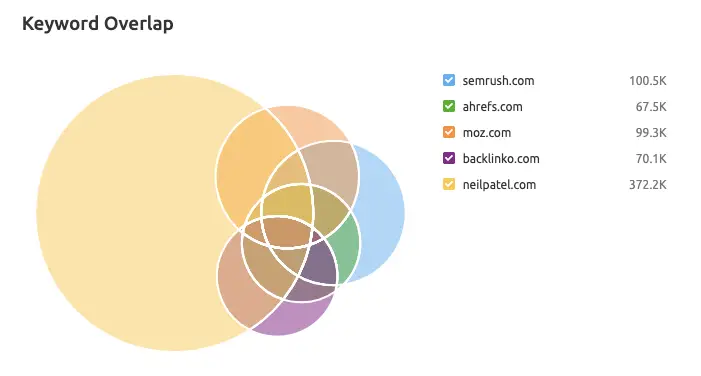Conducting and understanding the SEMRush keyword gap analysis
What is the SEMRush keyword gap analysis?
A keyword gap analysis looks at the keywords every domain in the competitive set is ranking for. It then groups the keywords based on multiple criteria like common, unique, or untapped keywords.
You can easily see how you stack up against the SEO results of your competition.
Let’s look at the step-by-step guide on how to conduct a keyword gap analysis in SEMRush.
Step 1: Adding the competitive set
There are two ways to define competitors: Your business competitors or organic competitors based on your current ranks. What’s the difference? The organic competitors are only in the competitive set because of your common keywords. This doesn’t mean that they sell the same services as you.
You can see your organic competitors when you run a domain overview in SEMRush. Also, as soon as you enter your domain to the competitive set in the keyword gap analysis, it will autosuggest the biggest keyword competition.
SEMRush Dashboard -> Competitive Research -> Keyword Gap

You can add up to five domains to run the keyword gap analysis. You also need to select the country database of keywords and choose between organic, paid, and PLA keywords.
Step 2: Keyword overlap
You can visually see the keyword overlap between all competitors and how many keywords they rank for in total.

This information is great to see the overall organic keyword size of the competitors and how much overlap there really is. In the above example of SEMRush’s competitive set, you see a dense overlap. That means that all sites are heavily competitive about the same search engine ranks.
Step 3: Shared keywords
You can look at all shared keywords or group them into predefined categories: Weak or strong.

Even though it may be overwhelming at first, I like to look at the shared keyword altogether. Because weak keywords are only those where your domain ranks the lowest out of all competitors. In the shared view I can also see keywords I am ranking second, third, or fourth-best.
When I go through the list, I usually sort it (default setting) by search volume. Then I go through the list and check every keyword I want to focus on later on and add to the Keyword Manager.
If I want to start with my best bets first, I apply an additional filter of keyword difficulty.
I don’t ignore the strong keywords (those I’m ranking the highest out of all competitors), but usually take fewer of those into my keyword manager.
Step 4: Missing and untapped keywords
The difference between missing and untapped keywords is that all other domains besides yours are ranking for the “missing” search terms. Untapped means that at least one competitor is ranking. This often includes branded names of the competitor etc.
Here it’s important to think back about the keyword overlap. The more all domains are overlapping the more relevant are the missing keywords. On the other side, the further the bubbles are apart, the less useful is the untapped group.
I first look at the missing because there’s probably a reason why all others are ranking for those. I focus on a mix of easier and volume keywords first and add them to my keyword manager.
At this point, I might be creating different lists to help me manage my project. Maybe I have a list for weak, another for missing, and yet another for strong.
Within the untapped category of SEMRush’s keyword gaps, I look also for keywords which at least two others are ranking for. But also skim through the entire list, because maybe only one competitor found a diamond in the rough and nobody is going after that.
SEMRush also has a suggested list for top bets.
Step 5: Unique keywords
I usually have a really quick look at those keywords because they are often my branded terms. But if I see big potential keywords that nobody else is targeting so far and I’m not in the top ranks, I might add this to my project to expedite the early success.
Step 6: Change the You domain
If I want to focus on one or two top competitors in more detail I can just switch the point of view and conduct the entire gap audit from their perspective.
In order to do this, just switch the domain all keywords are detailed for:

Step 7: Action Plan
Having the insights is great, but now I need to take action. I always recommend the following approach:
- Quick wins:
- Keywords that you are already ranking for (weak and shared but not strong). I prioritize pages that are already older (12+ months) and Keywords that have a good ratio between keyword difficulty and search volume.
- New content opportunities: I start with the top opportunities of untapped or missing
- Further keyword research: I don’t stop with the search terms in my list of keywords that your competitors rank for. There might be long-tail keywords to uncover, too. Here’s my tutorial on how to conduct keyword research in SEMRush.
- Optimize and create content with the help of SEMRush’s content creation tools
- If needed you can also implement backlinks. Here is my approach to SEMRush’s backlink analysis as well as backlink implementation tools
Go down my list of keywords and complete my keyword profile step by step
Optional Step 8: Repeat the process for paid keywords
You can also go through steps 2 – 6 for paid media keywords and PLA.
Some of the paid competitor keywords may be interesting for my organic research. Think it that way, if my competitor is willing to pay for that search term, it must be valuable.

Sascha is a Lifecycle Marketing Consultant with over 8 years of digital marketing experiences in Silicon Valley, the UK, and Germany.
After leading the demand generation for a 100+ million company, he decided to venture out on himself. He’s now helping clients to attract and convert more leads and customers.
His main focus are SEO, paid media & marketing automation – all with the focus to tie marketing campaigns to revenue.
Sascha has been featured in industry publications.



